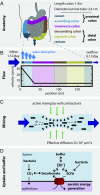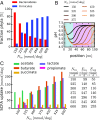Effect of water flow and chemical environment on microbiota growth and composition in the human colon
- PMID: 28588144
- PMCID: PMC5488924
- DOI: 10.1073/pnas.1619598114
Effect of water flow and chemical environment on microbiota growth and composition in the human colon
Abstract
The human gut harbors a dynamic microbial community whose composition bears great importance for the health of the host. Here, we investigate how colonic physiology impacts bacterial growth, which ultimately dictates microbiota composition. Combining measurements of bacterial physiology with analysis of published data on human physiology into a quantitative, comprehensive modeling framework, we show how water flow in the colon, in concert with other physiological factors, determine the abundances of the major bacterial phyla. Mechanistically, our model shows that local pH values in the lumen, which differentially affect the growth of different bacteria, drive changes in microbiota composition. It identifies key factors influencing the delicate regulation of colonic pH, including epithelial water absorption, nutrient inflow, and luminal buffering capacity, and generates testable predictions on their effects. Our findings show that a predictive and mechanistic understanding of microbial ecology in the gut is possible. Such predictive understanding is needed for the rational design of intervention strategies to actively control the microbiota.
Keywords: colon physiology; colonic pH; gut microbiota; stool consistency; water absorption.
Conflict of interest statement
The authors declare no conflict of interest.
Figures






Similar articles
-
Bacterial growth, flow, and mixing shape human gut microbiota density and composition.Gut Microbes. 2018 Nov 2;9(6):559-566. doi: 10.1080/19490976.2018.1448741. Epub 2018 May 9. Gut Microbes. 2018. PMID: 29533125 Free PMC article.
-
Stool consistency is strongly associated with gut microbiota richness and composition, enterotypes and bacterial growth rates.Gut. 2016 Jan;65(1):57-62. doi: 10.1136/gutjnl-2015-309618. Epub 2015 Jun 11. Gut. 2016. PMID: 26069274 Free PMC article.
-
A mathematical model to investigate the key drivers of the biogeography of the colon microbiota.J Theor Biol. 2019 Feb 7;462:552-581. doi: 10.1016/j.jtbi.2018.12.009. Epub 2018 Dec 7. J Theor Biol. 2019. PMID: 30529486
-
Human colonic microbiota: ecology, physiology and metabolic potential of intestinal bacteria.Scand J Gastroenterol Suppl. 1997;222:3-9. doi: 10.1080/00365521.1997.11720708. Scand J Gastroenterol Suppl. 1997. PMID: 9145437 Review.
-
The Gut Microbiome: Connecting Spatial Organization to Function.Cell Host Microbe. 2017 Apr 12;21(4):433-442. doi: 10.1016/j.chom.2017.03.010. Cell Host Microbe. 2017. PMID: 28407481 Free PMC article. Review.
Cited by
-
Competition for Hydrogen Prevents Coexistence of Human Gastrointestinal Hydrogenotrophs in Continuous Culture.Front Microbiol. 2020 May 29;11:1073. doi: 10.3389/fmicb.2020.01073. eCollection 2020. Front Microbiol. 2020. PMID: 32547517 Free PMC article.
-
Role of Microbiota in Pathogenesis and Management of Viral Hepatitis.Front Cell Infect Microbiol. 2020 Aug 11;10:341. doi: 10.3389/fcimb.2020.00341. eCollection 2020. Front Cell Infect Microbiol. 2020. PMID: 32850467 Free PMC article. Review.
-
A guide to plasma membrane solute carrier proteins.FEBS J. 2021 May;288(9):2784-2835. doi: 10.1111/febs.15531. Epub 2020 Sep 18. FEBS J. 2021. PMID: 32810346 Free PMC article. Review.
-
Deciphering the spatiotemporal transcriptional landscape of intestinal diseases (Review).Mol Med Rep. 2024 Sep;30(3):157. doi: 10.3892/mmr.2024.13281. Epub 2024 Jul 12. Mol Med Rep. 2024. PMID: 38994768 Free PMC article. Review.
-
Eco-evolutionary dynamics of a population with randomly switching carrying capacity.J R Soc Interface. 2018 Aug;15(145):20180343. doi: 10.1098/rsif.2018.0343. J R Soc Interface. 2018. PMID: 30135263 Free PMC article.
References
Publication types
MeSH terms
Grants and funding
LinkOut - more resources
Full Text Sources
Other Literature Sources
Molecular Biology Databases

